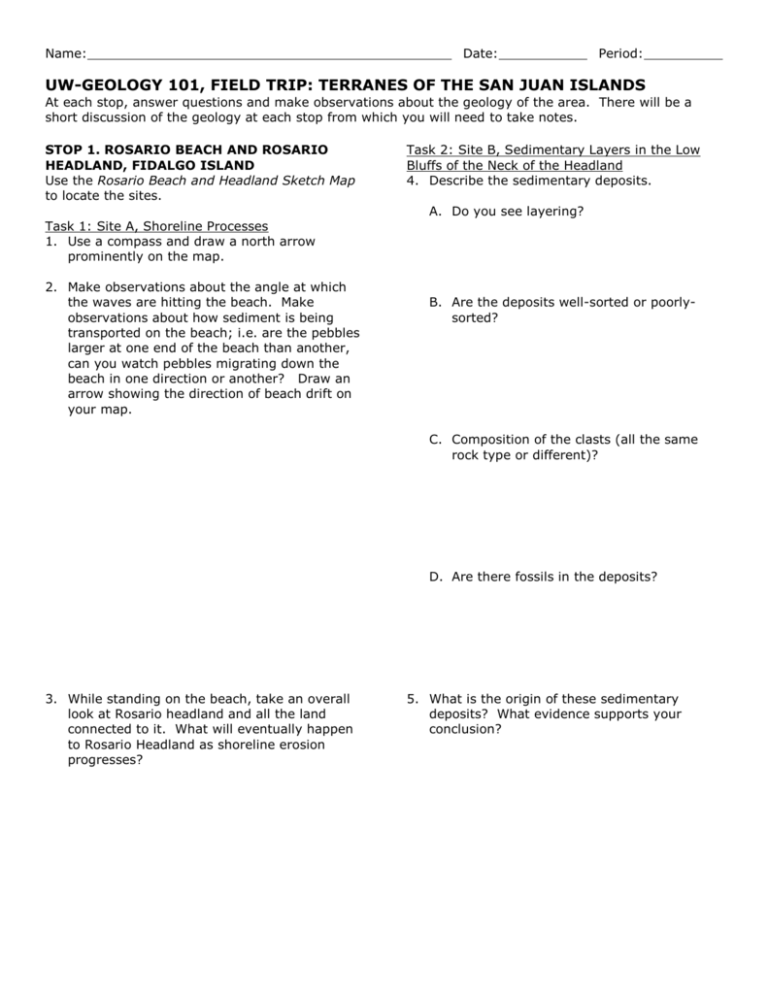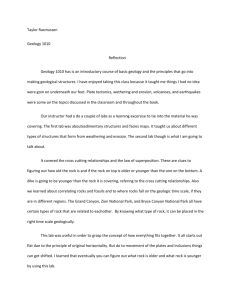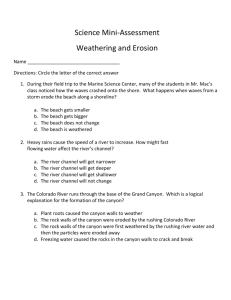Name:
advertisement

Name: Date: Period: UW-GEOLOGY 101, FIELD TRIP: TERRANES OF THE SAN JUAN ISLANDS At each stop, answer questions and make observations about the geology of the area. There will be a short discussion of the geology at each stop from which you will need to take notes. STOP 1. ROSARIO BEACH AND ROSARIO HEADLAND, FIDALGO ISLAND Use the Rosario Beach and Headland Sketch Map to locate the sites. Task 2: Site B, Sedimentary Layers in the Low Bluffs of the Neck of the Headland 4. Describe the sedimentary deposits. A. Do you see layering? Task 1: Site A, Shoreline Processes 1. Use a compass and draw a north arrow prominently on the map. 2. Make observations about the angle at which the waves are hitting the beach. Make observations about how sediment is being transported on the beach; i.e. are the pebbles larger at one end of the beach than another, can you watch pebbles migrating down the beach in one direction or another? Draw an arrow showing the direction of beach drift on your map. B. Are the deposits well-sorted or poorlysorted? C. Composition of the clasts (all the same rock type or different)? D. Are there fossils in the deposits? 3. While standing on the beach, take an overall look at Rosario headland and all the land connected to it. What will eventually happen to Rosario Headland as shoreline erosion progresses? 5. What is the origin of these sedimentary deposits? What evidence supports your conclusion? Task 3: Geology and Structure of Rosario Headland, Sites C, D, E, F. Please use extreme caution! These rocks are sharp and the cliffs are steep. E. What types of marine life do you find in the tide pools? 6. Site C, Located on the wave-cut platform at the bottom of the headland. A. Name the rock. 7. Site D, located upslope from Site C. A. Name and describe the rock. B. Describe the rock and draw a sketch with scale. B. Rock deformation: Are the layers horizontal or tilted? C. Find a distinctive layer and follow it. Is it folded? Faulted? 8. Site E, located below the cliff (the top of this rock unit can be viewed from Site D). C. Rock deformation: Are the layers horizontal or tilted? Describe the orientation of strike & dip. A. Describe the rock (color, possible origin). If it’s high tide, you might have a more difficult time reaching the rocks, so do the best you can. D. Find a distinctive layer and follow it. Is it folded? Faulted? B. Do they appear the same or different as Site C and D? 9. Site F, the rock that makes up the cliff face to the south. These rocks can be viewed from Site E and will have to be viewed from afar. B. Could it have eroded out of the bedrock here? If not, how did it get here? A. Name the rock type. Describe the rocks and draw a sketch with scale. 11. Summarize the geologic history of Sites C, D, E, and F. Draw the layers in the order that they were formed from oldest at the bottom to youngest at the top. Interpret the history as seen from the sequence of rock types. Youngest layer B. How do these rocks compare with those at Site E? Oldest layer C. Were these rocks erupted on land or under the sea? Explain. 10. Site G, find the large, rounded boulder on the south side of the headland. A. What kind of rock is it? STOP 2. SUNSET BEACH, WASHINGTON PARK C. What is the evidence for a marine origin (that is, deposition BELOW sea level) of the glaciomarine drift? Task 1. Bedrock geology of Washington Park 12. What is the name of the bedrock? Where could it have originated? 13. How did this rock get to the surface of the earth? D. The glaciomarine drift layers are now ABOVE sea level. Explain how this might have happened. 14. Describe the minerals in these veinlets (color, hardness, form). 16. In what direction did the glaciers move? How can you tell? Task 2: Glacial Geomorphology (Evidence for Glaciation) 15. What is the evidence that glaciers moved over this area? A. Evidence for erosion by glacial ice? Task 3: Correlating Outcrops Use your observations from Task 1 and 2 to interpret the geologic history of this area. 17. How do the ultramafic rocks seen here correlate to the rocks seen at Rosario Headland? B. Evidence for deposition of material by glacial ice? 18. In this box, draw a cross-section of the two rock units we observed. A. Next to the box, write a few words that describe the implied events that took place in order to form the stratigraphic sequence that we observe. STOP 4. MOUNT CONSTITUTION & THE MOUNT CONSTITUTION FORMATION 21. Pending weather, you should have a great view of Puget Sound and the San Juan Islands. After you take in the view, look at the rock you’re walking on. Why are these outcrops so rounded and smooth? B. Be sure to include the UNCONFORMITY. 22. Describe and identify the rock type here. STOP 5. NORTH BEACH & THE NANAIMO GROUP 25. Describe the rocks on the beach (types, sorting, roundness). STOP 3. BURROWS CHANNEL TRAIL, WASHINGTON PARK Look for a bedrock outcrop on the south side of the trail. Fragile rocks!! Please be gentle and do not harm this beautiful exposure. Preserve it for future generations of geology students. 19. Describe what you observe in this outcrop. Include a sense of scale in your description. 26. Where did these rocks come from? How do you know? 20. How did these features form in this outcrop? 27. Why is Sucia Island shaped the way it is? Describe the shape and how it was formed? STOP 6. FERRY TERMINAL & THE MT. CONSTITUTION FORMATION 30. This is a much better outcrop to examine rock type than on top of Mt. Constitution itself. Describe the rock type. 31. Interpret the geologic environment in which these rocks were deposited.







